Long-Term Forecasting Potential of Photo-Voltaic Electricity Generation and Demand Using R
Abstract
1. Introduction
2. Materials and Methods
2.1. Data Description
- Micro-grid data, two parameters. An initial cost analysis was performed on the hourly data from the micro-grid by [8] from April 2013 to March 2018. These data were recorded and obtained from a different data storage point in the Energy Management System and not yet cleansed. The data used in this study concerns per second data, from January 2015 to December 2017, which was obtained from the micro-grid data storage point and was cleansed as described in [9]. It was converted into hourly data to enable analysis with hourly weather data by means of averaging. Parameters of interest are purchased electricity and total solar power generation. For the purpose of this study, battery charging and discharging is ignored as it is of negligible proportions. The electricity amount and cost reduction function of the battery is active only during July, August, and September. Previous studies showed this amount is maximally 4.86% of the total building energy demand [10].
- Japan Meteorology Agency (JMA) data, six parameters. The hourly weather parameters for the corresponding time period of January 2015 to December 2017 were downloaded in csv files from the JMA website (freely accessible) [11] in batches of one month due to size restrictions. Parameters of interest are temperature, precipitation, sunlight, wind speed, solar irradiation, and humidity.
- Time parameters (6): year (note that due to the total data volume each year is calculated separately), month, day of month, day of week, hour, holiday.
- Electricity cost data, one parameter (see Figure 1). These data were obtained from the Facility Management Office of NIMS, based on the yearly renewed contract with the Tokyo Electric Power Company. The Feed in Tariff surcharge for renewable energy is included. Other factors such as fuel regulatory costs, basic connection to the electricity grid and spare line fees are not included since these are shared by the entire site and independent of building electricity use.
2.2. Approach
- Predictive modeling to determine what would be the output if a new (future) input is applied (to estimate future demand and solar power generation)
- Prescriptive modeling to optimization what actions should be taken given the data (to estimate the impact of additional storage devices)
2.3. Motivation for Software Choice
2.4. Data Cleansing
- 1.
- Removing missing values from the micro-grid data and replacing negative values with 0. For the micro-grid, this concerned the maintenance days in November (2015: November 14, 8:00–20:00, 2016: November 19, 8:00–19:00, 2017: November 18, 8:00–18:00). Two additional instances were found to have missing values (2015/11/13 12:00, 2017/09/25 21:00). For solar power generation, 269 negative values were recorded during nighttime in 2017, which were replaced with 0.
- 2.
- Removing JMA data with poor data quality. The JMA has excellent record keeping concerning data quality. Most values have the data quality value of “8: There are no missing data on the statistical basis (normal value)”. The number of instances when the data quality was less than this are described in Table 2. Values with data quality values of 4 (10 instances) or 5 (2 instances) were kept. There were several instances where data was missing for multiple parameters at the same time.
- 3.
- Removing outliers (see SM1: R code for outlier removal). Note that the parameter (relative) humidity is in % unit, and sunlight is relative to one full hour (1), and therefore these parameters should not have outliers removed. The hourly electricity price is given based on predetermined conditions and cannot have outliers. Precipitation occurs intermittently and in irregular amounts, meaning it is prone to outliers. This leaves three weather parameters and the two micro-grid parameters to remove outliers for. For the parameters “solar irradiation” and “total pv ac” outliers were calculated without taking the values of 0 into account. Extreme outliers were removed by calculating three times the interquartile range (iqr) using the following code:extreme_threshold_upper = (iqr * 3)+ upperqextreme_threshold_lower = lowerq − (iqr * 3)Boxplot results were used to show the difference before and after outlier removal. As an example, Figure 2 shows the data before and after removing outliers for the parameter wind speed, using data from 2015. Outliers were checked for overlap between parameters and consequently removed. Before outlier removal the standard deviation, mean, minimum and maximum values were calculated for the five parameters: wind speed, temperature, solar irradiation, total pv ac, and purchased electricity, for each year. Table 3 gives an overview of the found outliers.
- 4.
- Removing additional outliers occurring around maintenance days. After removal of the values in steps 1–3, we observed several remaining uncharacteristic data values occurring around the maintenance days. As example, from November 13 to 16 in 2015 the values for purchased electricity from the micro-grid were uncharacteristically low. The cause of these low values is most likely the shutdown of electricity dependent equipment in anticipation of and in reaction to the maintenance procedures, during which all electricity through the main power line is stopped. This led to the removal of 47 rows of data in 2015; 47 in 2016 and 49 in 2017. After this final removal step the standard deviation, mean, minimum and maximum values were calculated for the five parameters wind speed, temperature, solar irradiation, total pv ac, and purchased electricity, for each year.
2.5. Data Exploration (See SM2: R Code for Data Exploration Graphs)
2.6. Solar Power Generation–Linear Regression and Support Vector Regression (See SM3: R Code for Linear Regression and SVR (Support Vector Regression))
2.7. Building Energy Demand–Non-Linear Regression (See SM4: R Code for Plotting Nonlinear Regression)
2.8. Electricity Prices
3. Results
3.1. Data Cleansing (See SM5: R Code for Data Rows Graph)
3.2. Data Exploration
3.3. Solar Power Generation
3.4. Building Energy Demand
3.5. Electricity Prices
4. Discussion
5. Conclusions
Supplementary Materials
Author Contributions
Funding
Conflicts of Interest
Notes on References
Appendix A
| Parameter | Long Term | Medium Term | Short Term | Reference |
|---|---|---|---|---|
| Solar irradiance | 1–3 days | 1–6 h | 15 min–2 h | [20] |
| Solar irradiance | 28–45 h (1 day) | 1–6 h | - | [21] |
| Solar irradiance | 1 month | 1 day | 1 min | [22] |
| Building energy demand | 1–10 years | 1 month–1 year | 1 h–1 week | [23] |
| Building energy demand | > 1 year | 1 week–1 year | 1 h–1 week | [24] |
Appendix B
| Software | R | Python | Java | SAS | SPSS |
|---|---|---|---|---|---|
| Description | Developed by statisticians, aimed at handling numerical values; procedural language (step by step subroutines) | General purpose programming language, simple to read, used for websites; object oriented (bundles procedures and data together as parts of objects) | Programming language and computer platform; object oriented (bundles procedures and data together as parts of objects) | Statistical Analysis System, developed for analyzing large quantities of agriculture data | Statistical Package for the Social Sciences, the first statistical programming language for the PC |
| Advantages | Free, easy to learn, many options for data visualization, suited for statistical analysis and explanatory and predictive modeling | Free, easy to learn, built-in debugging | High speed | Easy to handle large datasets | Good user interface, official support, easy to learn and write code, similar to Excel |
| Disadvantages | No official support or user interface | Slow with large datasets | Not strong in statistical modeling and visualization | High learning curve | Slow with large datasets |
Appendix C
References
- González, R.M.; Wattjes, F.D.; Gibescu, M.; Vermeiden, W.; Slootweg, J.G.; Kling, W.L. Applied Internet of Things Architecture to Unlock the Value of Smart Microgrids. IEEE Internet Things J. 2018, 5, 5326–5336. [Google Scholar] [CrossRef]
- Vink, K.; Ankyu, E.; Koyama, M. Multiyear microgrid data from a research building in Tsukuba, Japan. Sci. Data 2019, 6, 190020. [Google Scholar] [CrossRef] [PubMed]
- Mocanu, E. Machine Learning Applied to Smart Grids. Ph.D. Thesis, Eindhoven University of Technology, Eindhoven, The Netherlands, 2017. [Google Scholar]
- Mocanu, E.; Nguyen, P.H.; Gibescu, M.; Kling, W.L. Comparison of machine learning methods for estimating energy consumption in buildings. In Proceedings of the 2014 International Conference on Probabilistic Methods Applied to Power Systems (PMAPS), Durham, UK, 7–10 July 2014. [Google Scholar]
- Sharma, N.; Sharma, P.; Irwin, D.; Shenoy, P. Predicting solar generation from weather forecasts using machine learning. In Proceedings of the 2011 IEEE International Conf. on Smart Grid Communications (SmartGridComm), Brussels, Belgium, 17–20 October 2011; pp. 528–533. [Google Scholar]
- Larson, D.P.; Nonnenmacher, L.; Coimbra, C.F.M. Day-ahead forecasting of solar power output from photovoltaic plants. Renew. Energ. 2016, 91, 11–20. [Google Scholar] [CrossRef]
- Dupré, O.; Vaillon, R.; Green, M.A. Thermal Issues in Photovoltaics and Existing Solutions. In Thermal Behavior of Photovoltaic Devices, 1st ed.; Dupré, O., Vaillon, R., Green, M.A., Eds.; Springer: Berlin/Heidelberg, Germany, 2017; pp. 1–28. [Google Scholar] [CrossRef]
- Vink, K.; Ankyu, E.; Elborg, M.; Koyama, M. Performance and cost analysis of building scale micro-grid operation. Energ. Procedia 2019, 156, 425–429. [Google Scholar] [CrossRef]
- Ankyu, E.; Vink, K.; Koyama, M. Economic evaluation of big data analysis and peak cut operation of micro grid system (Japanese). In Proceedings of the Japan Computer Chemistry Society 2018 Fall meeting, Hirosaki, Japan, 3–4 November 2018. [Google Scholar] [CrossRef]
- Ankyu, E.; Vink, K.; Koyama, M. Optimization of the micro-grid system using the actual data of the NanoGREEN/WPI-MANA building. In Proceedings of the 20th GREEN Symposium, Tsukuba, Japan, 19 February 2019. [Google Scholar]
- Japan Meteorological Agency. Past Weather Data Download (Japanese). 2018. Available online: http://www.data.jma.go.jp/gmd/risk/obsdl/index.php (accessed on 18 May 2020).
- Russell, S.J.; Norvig, P. Supervised Learning. In Artificial Intelligence: A Modern Approach, 3rd ed.; Russell, S.J., Norvig, P., Eds.; Prentice Hall: Upper Saddle River, NJ, USA, 2010; pp. 695–697. [Google Scholar]
- Solar Panel Analysis Part 1: Exploration. Available online: https://www.jeroenboeye.com/blog/solar-panel-analysis-pt-1-exploration/ (accessed on 18 May 2020).
- Using Linear Regression for Predictive Modeling in R. Available online: https://www.dataquest.io/blog/statistical-learning-for-predictive-modeling-r/ (accessed on 18 May 2020).
- Support Vector Regression with R. Available online: https://www.svm-tutorial.com/2014/10/support-vector-regression-r/ (accessed on 18 May 2020).
- Karatzoglou, A.; Meyer, D. Support Vector Machines in R. J. Stat. Softw. 2006, 15. [Google Scholar] [CrossRef]
- Performing Nonlinear Least Square and Nonlinear Regressions in R. Dataconomy. Available online: https://dataconomy.com/2017/08/nonlinear-least-square-nonlinear-regression-r/ (accessed on 18 May 2020).
- BBC Visual and Data Journalism Cookbook for R Graphics, How to Create BBC Style Graphics. Available online: https://bbc.github.io/rcookbook/ (accessed on 18 May 2020).
- Davo, F.; Alessandrini, S.; Sperati, S.; Delle Monache, L.; Airoldi, D.; Vespucci, M.T. Post-processing techniques and principal component analysis for regional wind power and solar irradiance forecasting. Solar Energ. 2016, 134, 327–338. [Google Scholar] [CrossRef]
- Diagne, H.M.; David, M.; Lauret, P.; Boland, J.; Schmutz, N. Review of solar irradiance forecasting methods and a proposition for small-scale insular grids. Renew. Sustain. Energ. Rev. 2013, 27, 65–76. [Google Scholar] [CrossRef]
- Persson, C.; Bacher, P.; Shiga, T.; Madsen, H. Multi-site solar power forecasting using gradient boosted regression trees. Solar Energ. 2017, 150, 423–436. [Google Scholar] [CrossRef]
- Voyant, C.; Notton, G.; Kalogirou, S.; Nivet, M.L.; Paoli, C.; Motte, F.; Fouilloy, A. Machine learning methods for solar radiation forecasting: A review. Renew. Energ. 2017, 105, 569–582. [Google Scholar] [CrossRef]
- Raza, M.Q.; Khosravi, A. A review on artificial intelligence based load demand forecasting techniques for smart grid and buildings. Renew. Sustain. Energ. Rev. 2015, 50, 1352–1372. [Google Scholar] [CrossRef]
- Mocanu, E.; Nguyen, H.P.; Gibescu, M.; Kling, W.L. Deep learning for estimating building energy consumption. Sustain. Energ. Grids Netw. 2016, 6, 91–99. [Google Scholar] [CrossRef]
- Ozgur, C.; Colliau, T.; Rogers, G.; Hughes, Z. MatLab vs. Python vs. R. J. Data Sci. 2016, 15, 355–372. [Google Scholar] [CrossRef]
- Java, P.R. Scala: Many Languages that Big Data Speaks. Available online: https://www.linkedin.com/pulse/java-python-r-scala-many-languages-big-data-speaks-debajani/ (accessed on 18 May 2020).
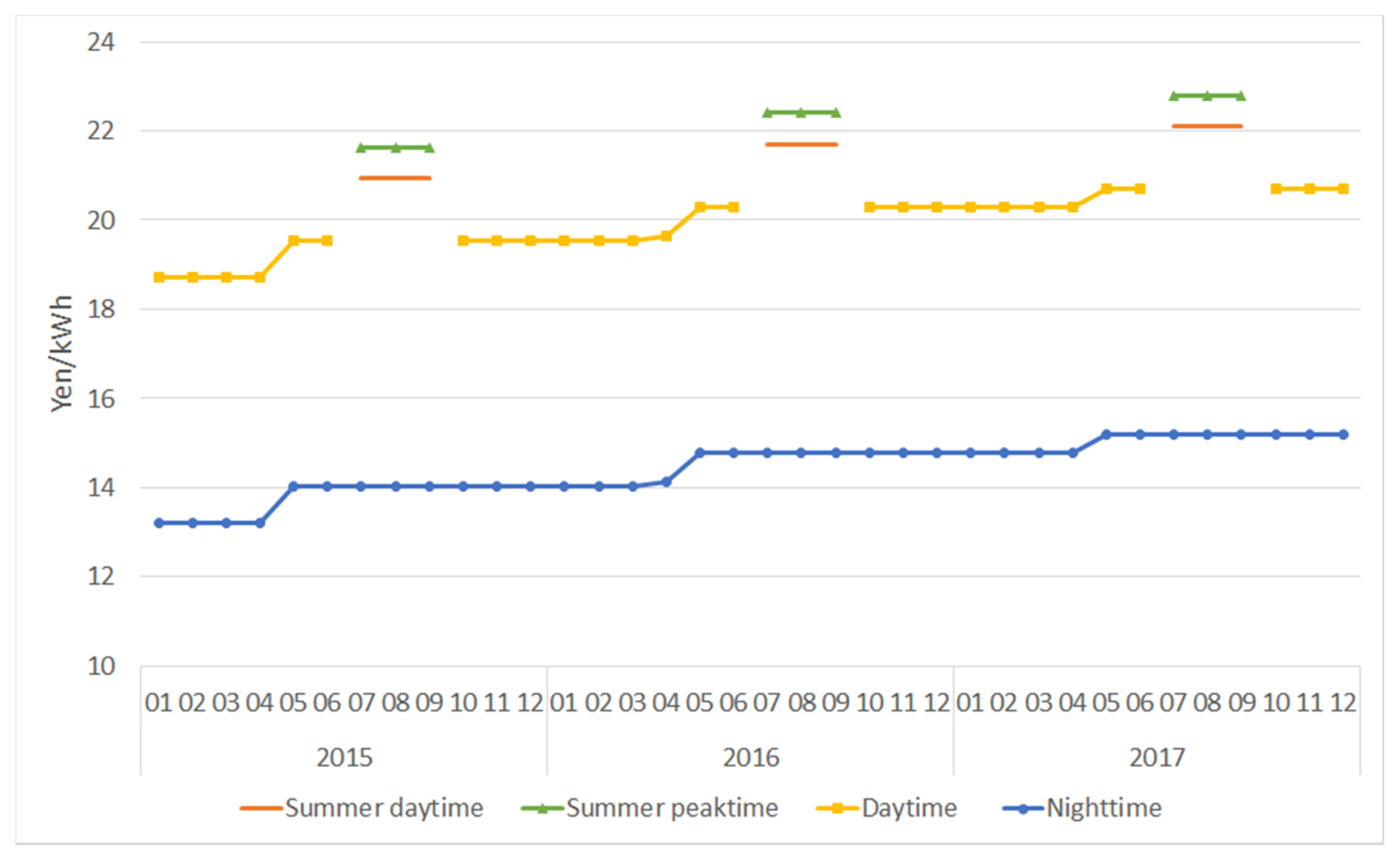
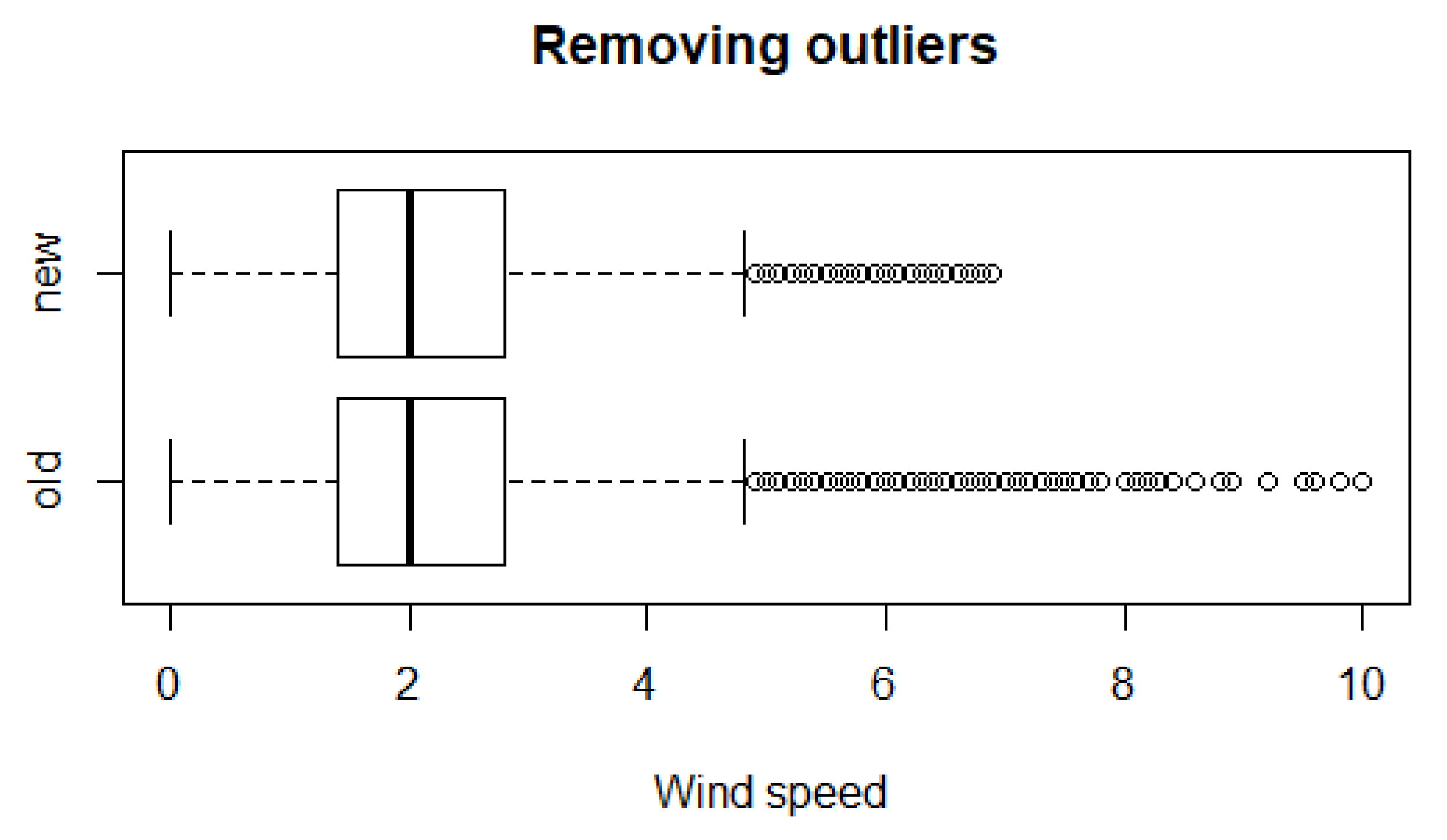
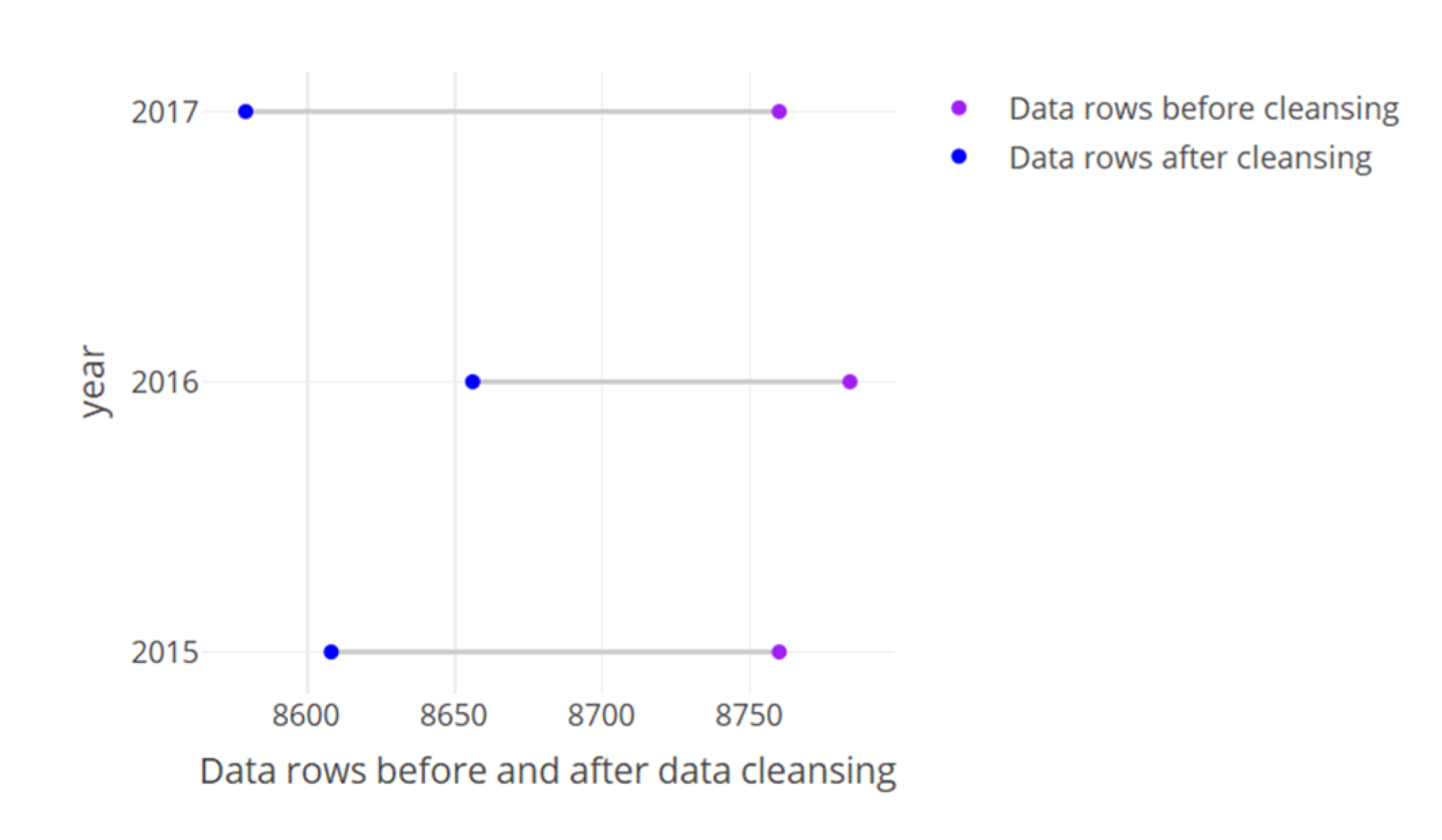
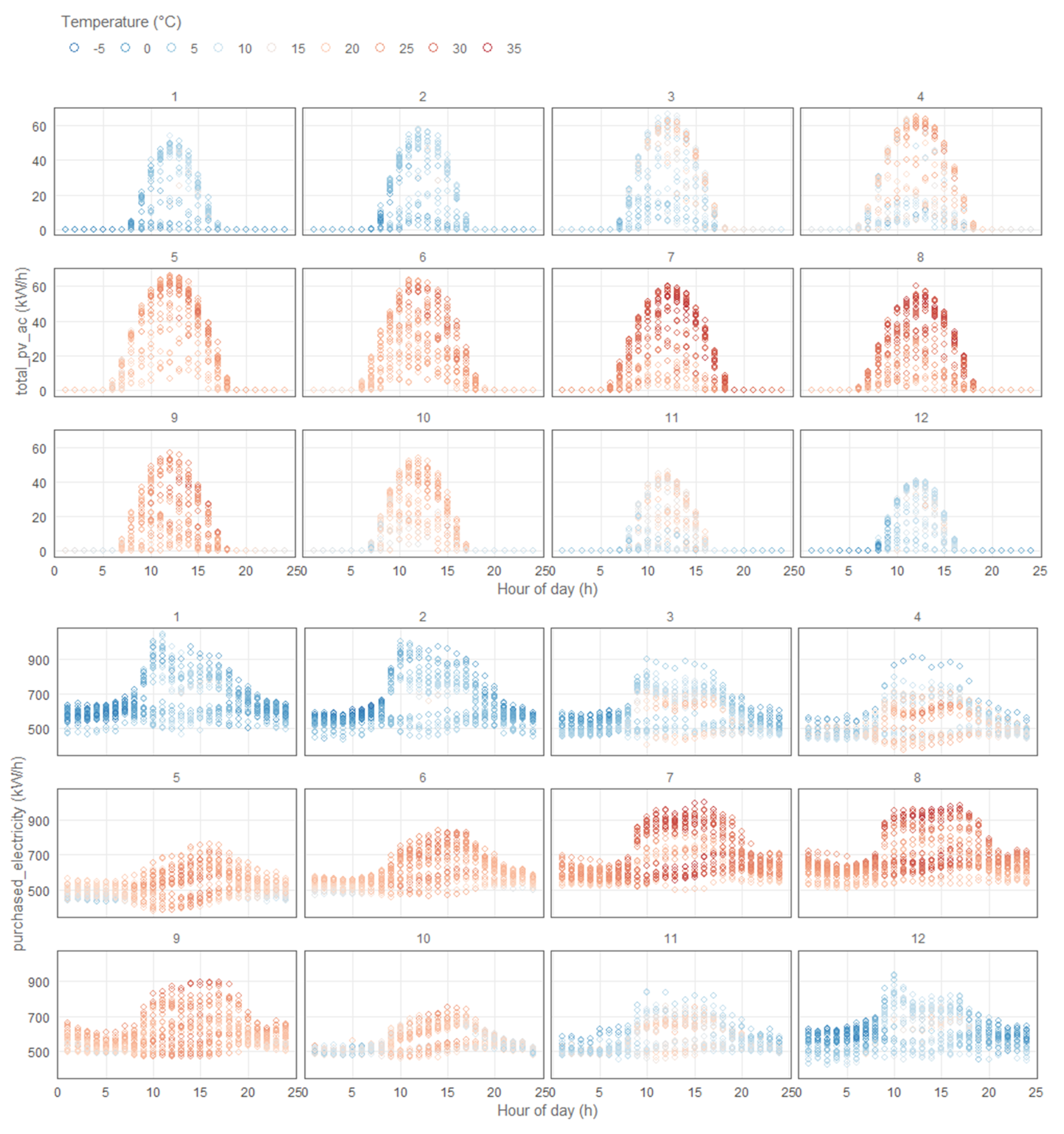
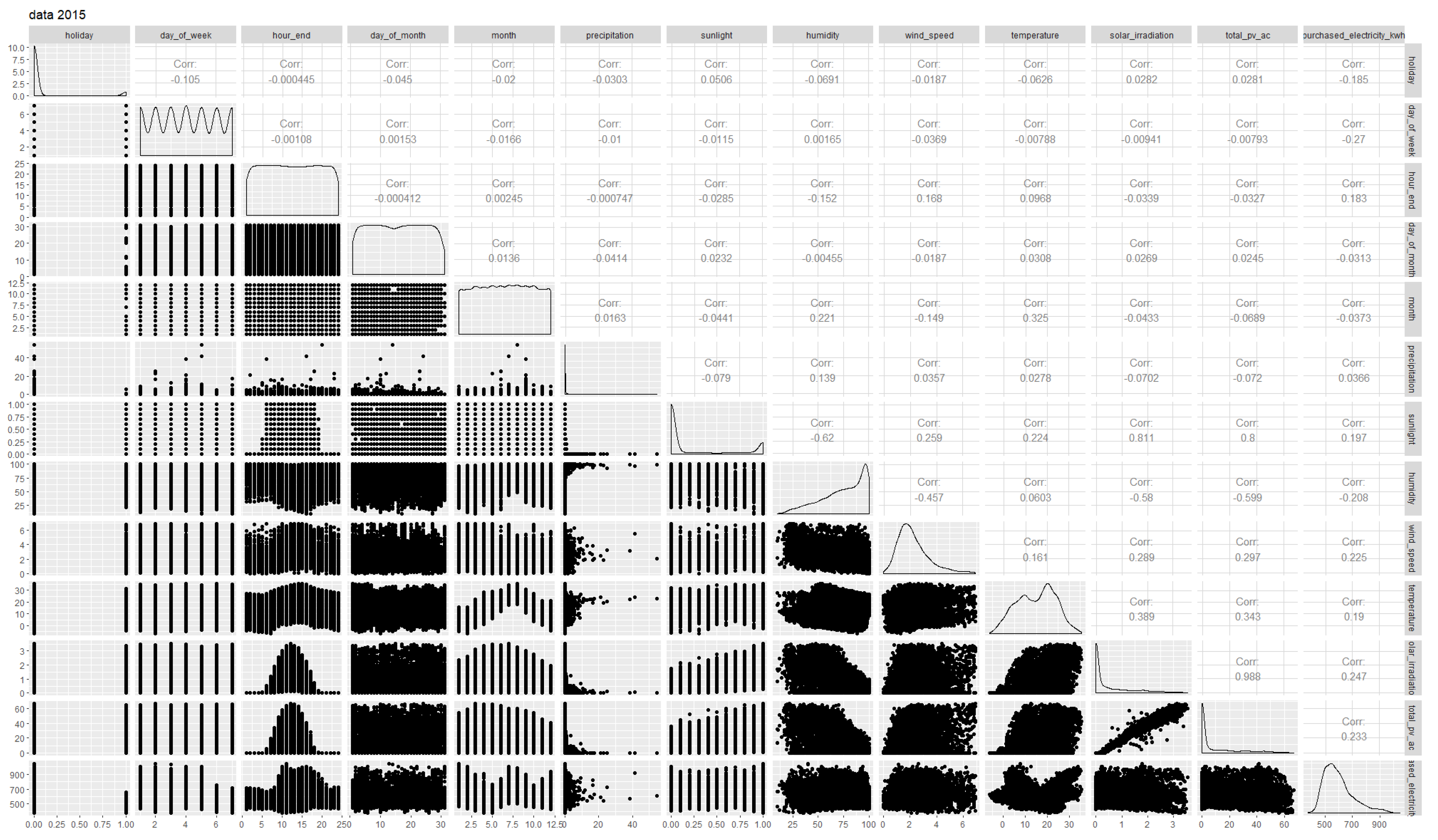
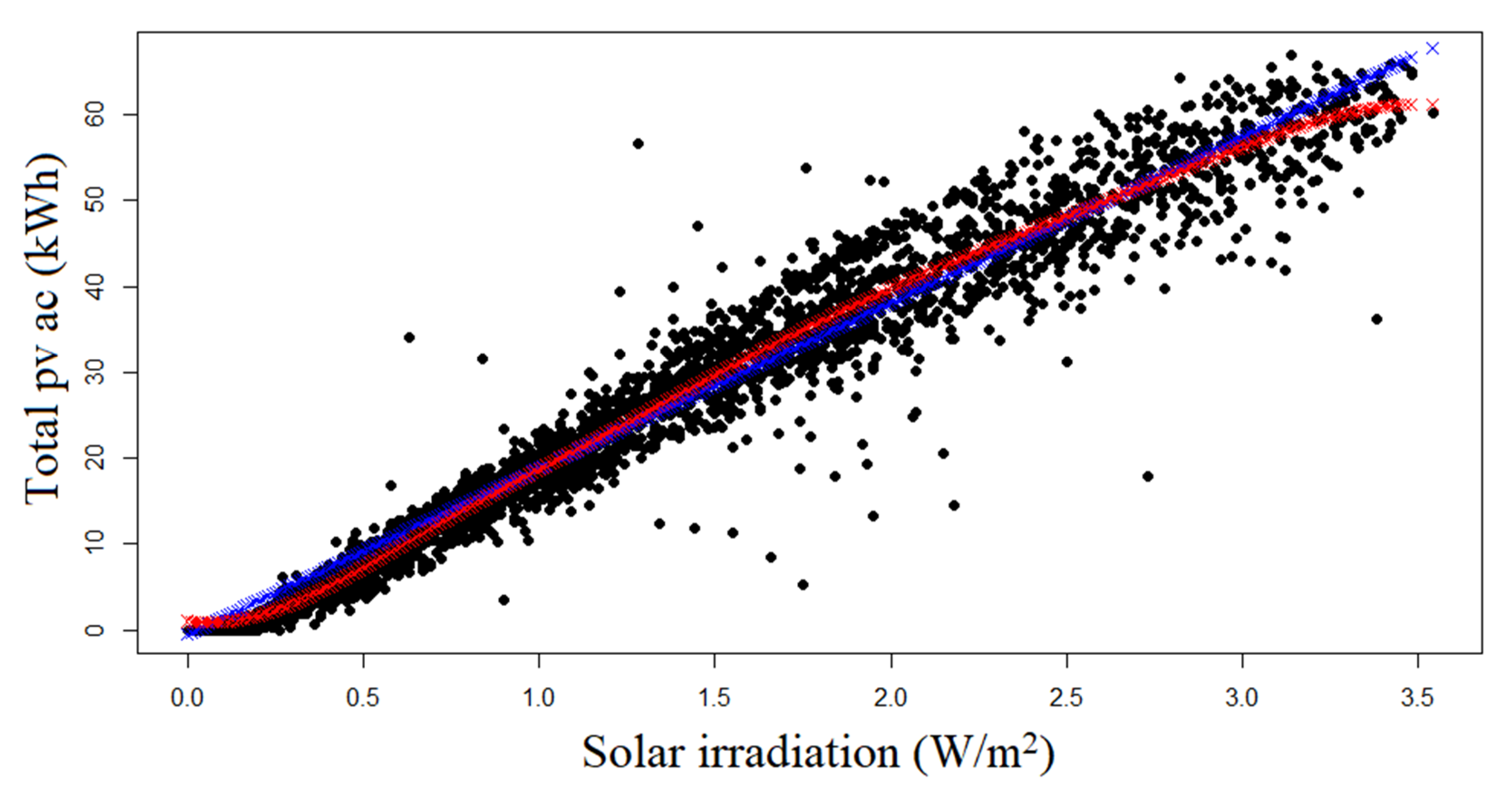
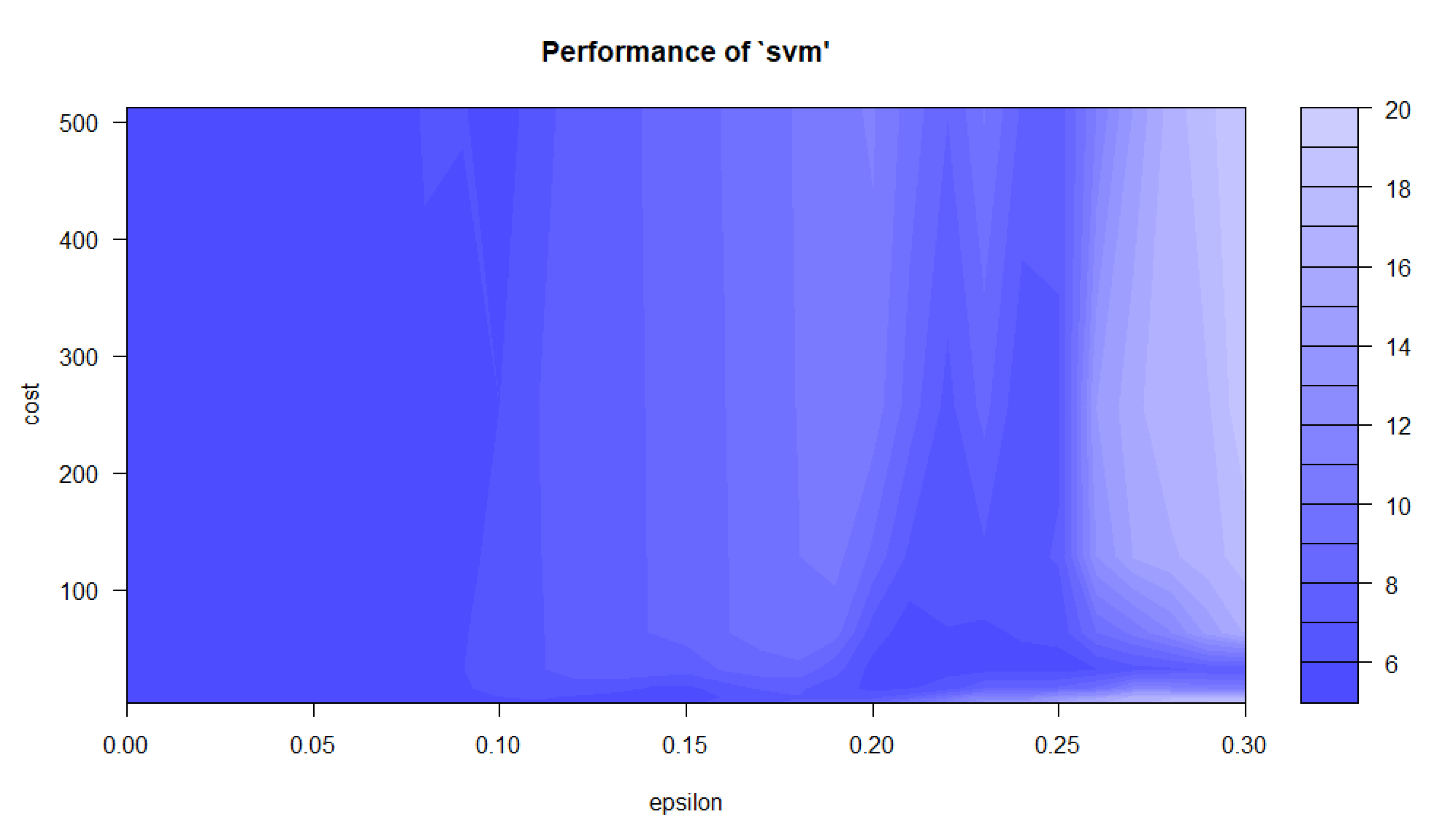
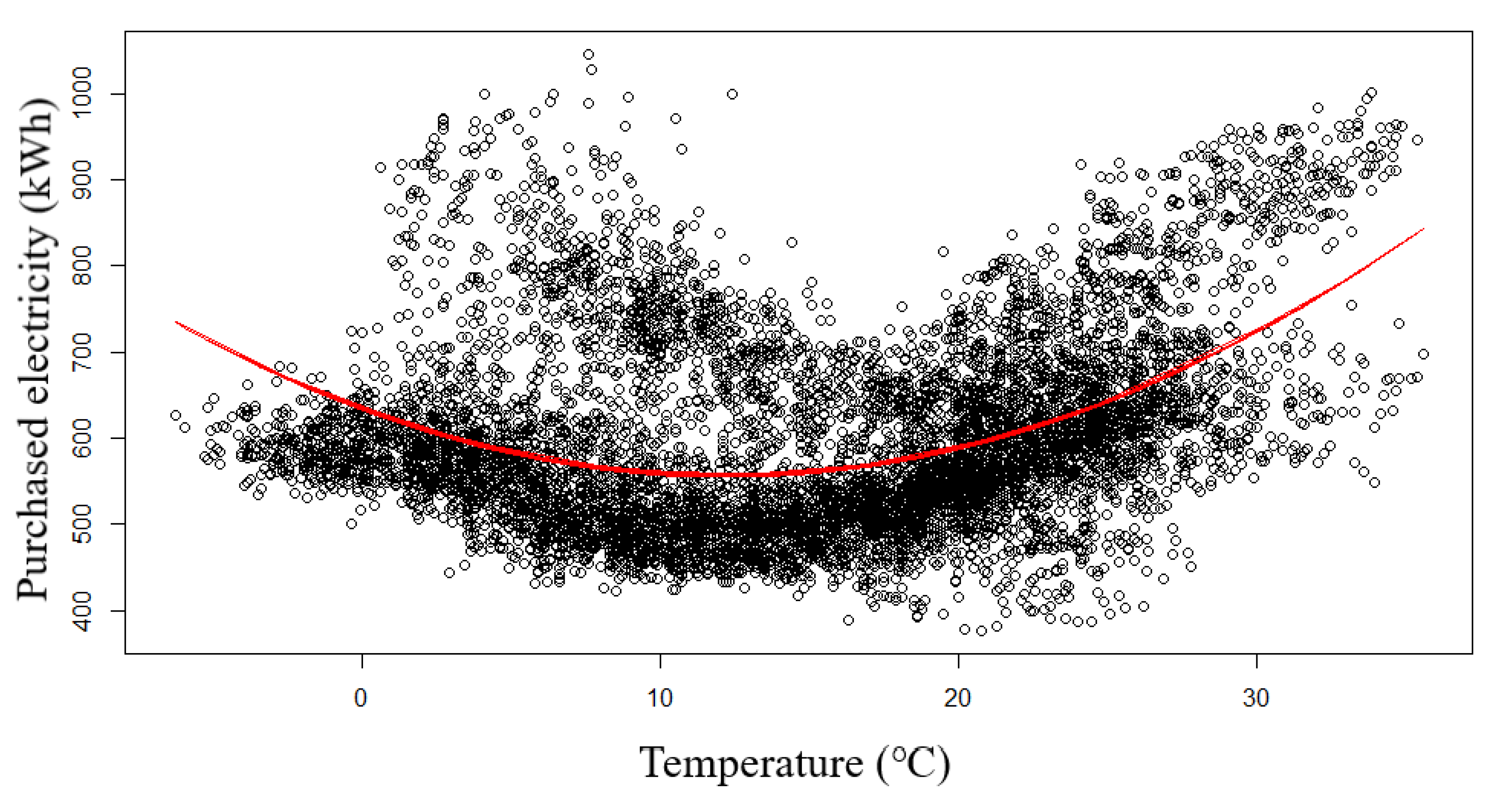
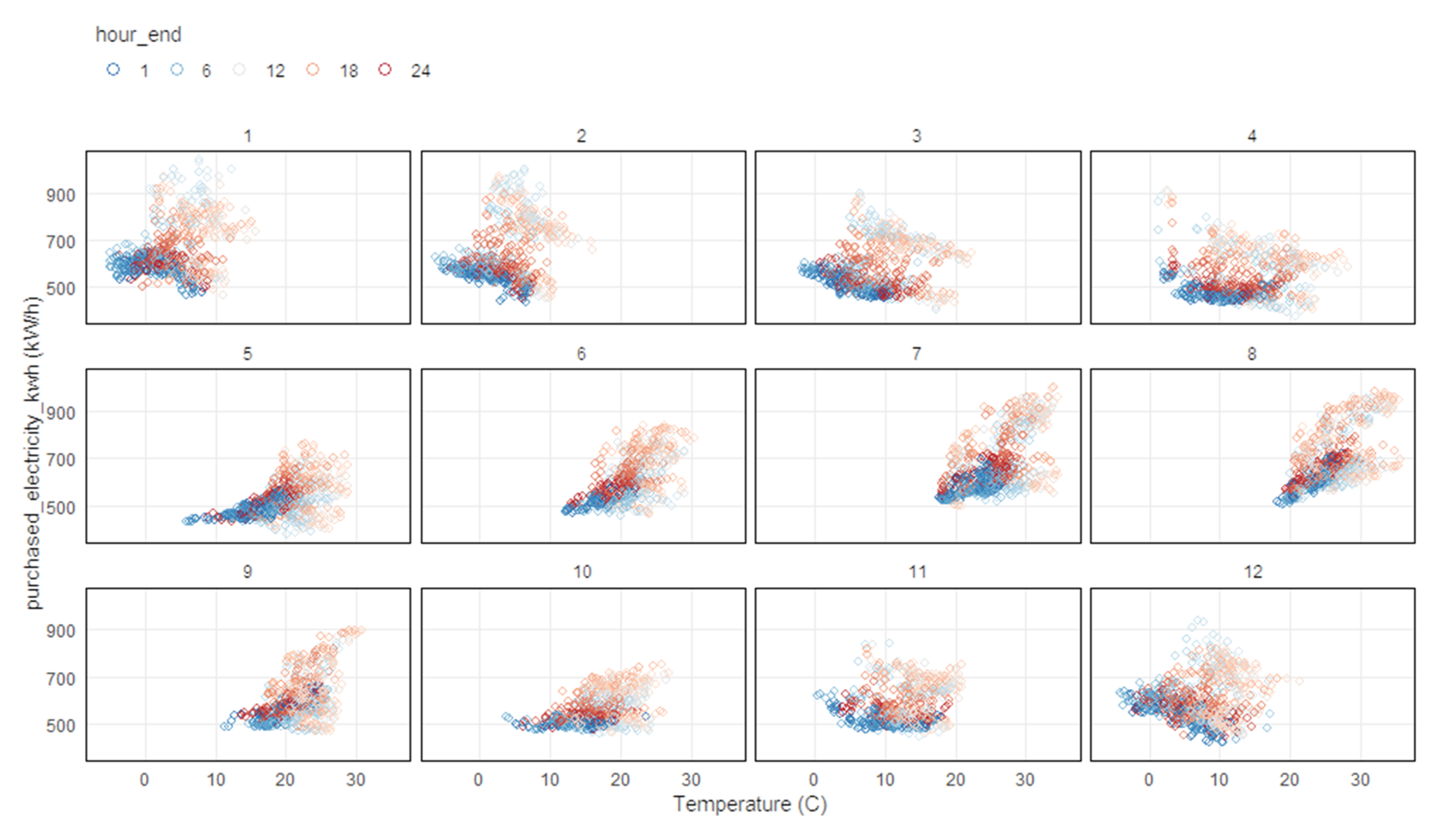
| Data Source | Parameter Name | Parameter Unit |
|---|---|---|
| NanoGREEN/WPI-MANA micro-grid | total_pv_ac | kWh (alternating current) |
| purchased_electricity_kwh | kWh | |
| Japan Meteorological Agency (JMA) | temperature | ℃ |
| precipitation | mm | |
| sunlight | numeral (between 0–1 h) | |
| wind_speed | m/s | |
| solar_irradiation | W/m2 | |
| humidity | % | |
| Time parameters | month | month (1–12) |
| day_of_month | day (1–31) | |
| hour_end | hour (1–24) | |
| day_of_week | day (1–7, starting on Monday) | |
| holiday | numeral (0 for no holiday, 1 for holiday) | |
| National Institute of Materials Science (NIMS) Facility Management Office | electricity price | JPY (Japanese Yen) |
| Year | 2015 | 2016 | 2017 | 2015 | 2016 | 2017 | 2015 | 2016 | 2017 | |
|---|---|---|---|---|---|---|---|---|---|---|
| # | JMA weather parameter data quality | 5: There is a deficit of 20% or less of the data that is the basis of statistics (quasi-normal value) | 4: There is a deficit exceeding 20% in the data underlying the statistics (lack of data) | 1: There is no statistical value (missing) | ||||||
| 1 | Temperature | - | - | - | - | - | - | - | - | 2 |
| 2 | Precipitation | - | - | - | - | - | - | - | - | - |
| 3 | Sunlight | - | - | 1 | - | 1 | 3 | - | - | 22 |
| 4 | Wind speed | - | - | - | - | - | - | - | 1 | 2 |
| 5 | Solar irradiance | 1 | - | - | 2 | 2 | 2 | 1 | - | 2 |
| 6 | Humidity | - | - | - | - | - | - | - | - | 2 |
| Parameter Name | 2015 | 2016 | 2017 |
|---|---|---|---|
| wind_speed | 88 | 68 | 100 |
| temperature | 0 | 0 | 0 |
| solar_irradiation | 0 | 0 | 0 |
| total_pv_ac | 0 | 0 | 0 |
| purchased_electricity_kwh | 2 | 0 | 0 |
| Case # | Day of Week | Time of Day | Holiday |
|---|---|---|---|
| 1 | Weekday | Day time | No holiday |
| 2 | Weekday | Day time | Holiday |
| 3 | Weekday | Night time | No holiday |
| 4 | Weekday | Night time | Holiday |
| 5 | Weekend | Day time | No holiday |
| 6 | Weekend | Day time | Holiday |
| 7 | Weekend | Night time | No holiday |
| 8 | Weekend | Night time | Holiday |
| Parameter | 2015 | 2016 | 2017 | ||||
|---|---|---|---|---|---|---|---|
| Pre-Cleansing | Post-Cleansing | Pre-Cleansing | Post-Cleansing | Pre-Cleansing | Post-Cleansing | ||
| Wind speed | SD | 1.304764 | 1.188131 | 1.266143 | 1.167836 | 1.267896 | 1.131123 |
| Mean | 2.285958 | 2.233074 | 2.265922 | 2.226386 | 2.235808 | 2.174749 | |
| Min | 0 | 0 | 0 | 0 | 0 | 0 | |
| Max | 10 | 6.9 | 10.5 | 6.9 | 11.1 | 6.6 | |
| Temperature | SD | 8.567907 | 8.599083 | 8.737433 | 8.760915 | 9.043145 | 9.069151 |
| Mean | 14.9803 | 14.98214 | 14.95232 | 14.96025 | 14.28081 | 14.32673 | |
| Min | −6.3 | −6.3 | −6.0 | −6.0 | −6.5 | −6.5 | |
| Max | 35.6 | 35.6 | 35.5 | 35.5 | 34.4 | 34.4 | |
| Solar irradiation | SD | 0.9289794 | 0.9274603 | 0.9168617 | 0.9157871 | 0.9353226 | 0.9356301 |
| Mean | 1.058775 | 1.049586 | 1.058818 | 1.056141 | 1.103574 | 1.094547 | |
| Min | 0.01 | 0.01 | 0.01 | 0.01 | 0.01 | 0.01 | |
| Max | 3.54 | 3.54 | 3.64 | 3.64 | 3.63 | 3.63 | |
| Total pv ac | SD | 18.35157 | 18.27055 | 17.2445 | 17.20114 | 17.07312 | 17.04483 |
| Mean | 23.1429 | 22.89964 | 22.08021 | 22.02548 | 22.62292 | 22.40334 | |
| Min | 0.000466667 | 0.000466667 | 0.000466667 | 0.000466667 | 0.000466667 | 0.000466667 | |
| Max | 66.8908 | 66.8908 | 66.43907 | 66.43907 | 63.05009 | 63.05009 | |
| Purchased electricity | SD | 111.1321 | 109.3086 | 122.9744 | 120.7636 | 115.5117 | 113.9781 |
| Mean | 597.4223 | 598.4304 | 648.3106 | 649.815 | 692.5064 | 693.0694 | |
| Min | 212.8308 | 377.3867 | 218.2507 | 409.1167 | 276.9287 | 459.414 | |
| Max | 1138.182 | 1045.367 | 1105.39 | 1105.39 | 1133.443 | 1133.443 | |
| Year | Intercept (a) | Slope (b) | LM RSME | SVR RSME | Tuned SVR RSME | Epsilon | Cost |
|---|---|---|---|---|---|---|---|
| 2015 | −0.5101 | 19.2985 | 2.527038 | 2.37958 | 2.263242 | 0.08 | 8 |
| 2016 | −0.5088 | 18.4918 | 2.204646 | 1.974913 | 1.888035 | 0.06 | 128 |
| 2017 | −0.4922 | 18.0549 | 2.181584 | 2.37958 | 2.263037 | 0.08 | 4 |
| Average | −0.5037 | 18.61506667 |
| Year | LM Error | NLM Error | Intercept (a) | Slope (b) | Curve (c) | Residual Sum of Squares | Tolerance |
|---|---|---|---|---|---|---|---|
| 2015 | 107.3204 | 99.04455 | 633.1747 | 12.7784 | 0.5251 | 84,442,961 | 1.83 × 10−9 |
| 2016 | 113.8353 | 103.4177 | 660.1028 | 13.3542 | 0.6305 | 92,577,853 | 4.283 × 10−9 |
| 2017 | 109.8714 | 102.973 | 698.3077 | 9.8411 | 0.4722 | 90,956,240 | 8.543 × 10−9 |
| Average | 663.8617333 | 11.99123333 | 0.5426 |
| Parameter | 2015 | 2015 | % | 2016 | 2016 | % | 2017 | 2017 | % |
|---|---|---|---|---|---|---|---|---|---|
| total_pv_ac (costs saved) | 1579 | 1557 | −1.36% | 1594 | 1643 | +3.08% | 1651 | 1740 | +5.41% |
| purchased_electricity_kwh (costs made) | 86,669 | 92,049 | +6.21% | 99,253 | 97,304 | −1.96% | 107,646 | 99,142 | −7.90% |
© 2020 by the authors. Licensee MDPI, Basel, Switzerland. This article is an open access article distributed under the terms and conditions of the Creative Commons Attribution (CC BY) license (http://creativecommons.org/licenses/by/4.0/).
Share and Cite
Vink, K.; Ankyu, E.; Kikuchi, Y. Long-Term Forecasting Potential of Photo-Voltaic Electricity Generation and Demand Using R. Appl. Sci. 2020, 10, 4462. https://doi.org/10.3390/app10134462
Vink K, Ankyu E, Kikuchi Y. Long-Term Forecasting Potential of Photo-Voltaic Electricity Generation and Demand Using R. Applied Sciences. 2020; 10(13):4462. https://doi.org/10.3390/app10134462
Chicago/Turabian StyleVink, Karina, Eriko Ankyu, and Yasunori Kikuchi. 2020. "Long-Term Forecasting Potential of Photo-Voltaic Electricity Generation and Demand Using R" Applied Sciences 10, no. 13: 4462. https://doi.org/10.3390/app10134462
APA StyleVink, K., Ankyu, E., & Kikuchi, Y. (2020). Long-Term Forecasting Potential of Photo-Voltaic Electricity Generation and Demand Using R. Applied Sciences, 10(13), 4462. https://doi.org/10.3390/app10134462




